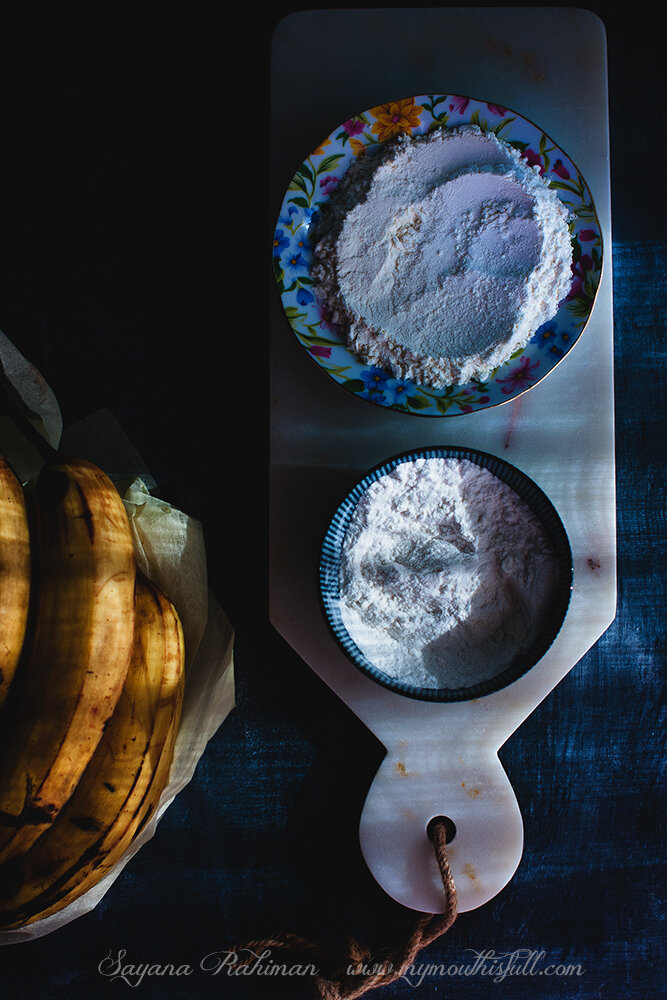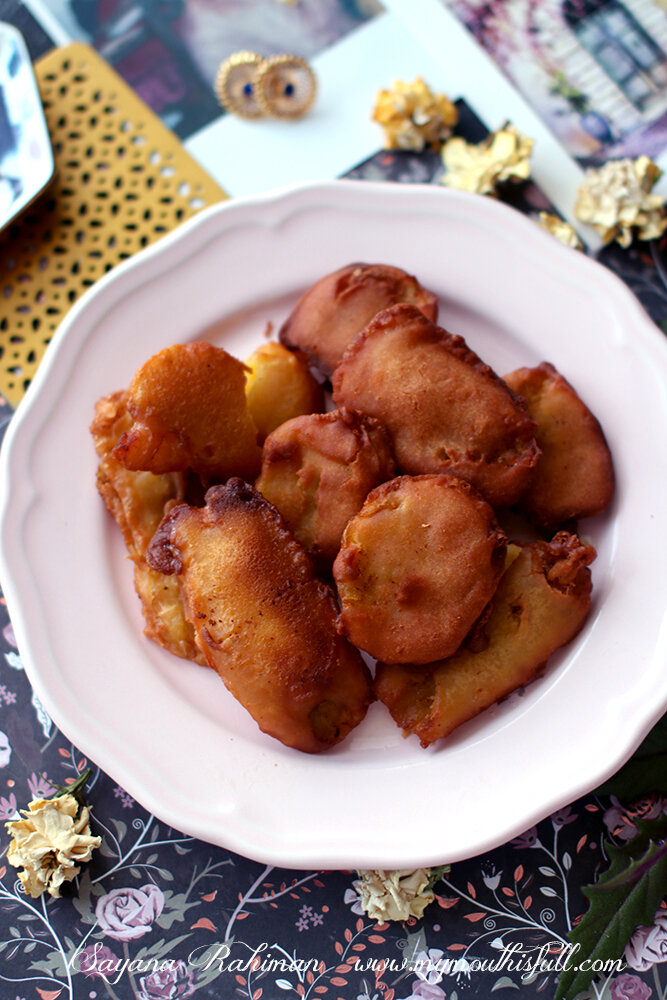
The twentieth day of Ramadan. Today marks three years since my paternal grandmother left us. In her loving memory, today I want to share her recipe for Pazham Pori. This is essentially a snack made right after a long siesta and is served alongside piping cups of tea. She was very fond of bananas and she always tried to convince me to have a couple of Cheru Pazham or baby bananas immediately after lunch when we visited her for the summer. Plantains were never out of stock in her kitchen. When visitors would come unannounced as was the norm in her time, in all probability she would have the help at home make a plate of these. Ripe plantains are slivered and dipped in a batter, which I later learnt, was her original recipe. I didn’t care too much for them till I started tasting versions made in other households. I still remember waiting for Umma to finish frying them so I could help myself to the bowl of leftover batter. It tasted blissfully similar to cake.

The number of recipes and dishes that is made from Plantains is a feat Malayalees have perfected. Boiled, steamed, mashed and pureed, there are recipes ranging from every day accompaniments on the breakfast to delicacies that grace feasts laid out for a newly married couple. A closer look into the food landscape in Kerala, recipes begin to show differences in ingredients, methods and even names through districts. Pazham Porichathu is arguably one of the few dishes that are a staple across Kerala. Roadside tea stalls that dot the winding highways play host to men in the neighborhood pausing their day holding glasses of frothy tea and you can always spot these fritters laid out to rest on newspapers that darken and soak up the oil it was fried in. A glaring difference would be the monstrous size as they are cut into very large shapes. Nothing like the dainty ones made at home.

If you look at a few recipes of these fritters, the batter is almost always made of sugar, flour and water. Nowadays, a pinch of baking soda is added to have it puff slightly when fried. That is how Vellima’s recipe is starkly different. Firstly, she uses a combination of flour and roasted rice flour. Rice flour isn’t extra fine in texture and you can taste the difference when you eat them. It gives it a gritty bite without being unpleasant. The next difference is the choice of sweetener.

The fritters I’ve seen and had in other households looked quite pale compared to Vellima’s. This is solely because she used Jaggery syrup to sweeten the batter. Cubes of jaggery are placed in a pot of water and heated until the blocks melt completely and the syrup reduces quite a bit and starts to look a lot like Molasses. It’s used for making Payasams, puddings made with thin rice flakes or soaked mung beans and when in season, the coveted Jackfruit. Coming back to the syrup, tablespoons full are added to the batter which simultaneously lends them a darker color when fried. Another reason why these are a bit darker is because she added a lightly beaten egg to the batter. I feel this is why it tastes so much like cake batter. The addition of egg makes the fritters puff up ever so slightly making it a little airy. To mellow the ‘egginess’ of the batter, a few pods of Cardamom are crushed and sprinkled over the batter. It gives a very subtle flavor and yet if you forgot to add it, the flavor of the egg stands out unabashedly. Speaking of hues, she would add a generous pinch of Turmeric powder which when stirred colored the batter to a sunshine yellow. I’ve saved the biggest difference for the very end. Her binding agent was freshly pressed coconut milk. At Vellima’s home, coconut milk was made for every meal of the day. I still remember her soaking Chappati in coconut milk for dinner. In this recipe, water isn’t used to combine the dry ingredients. In this recipe, once all the dry ingredients are whisked briefly with the egg, coconut milk is added in intervals till the batter comes together. It is quite which means it coats and binds to the sliced Plantain surfaces without sliding off. When it comes to frying, I strongly recommend to use Coconut oil. Almost all the traditional recipes calls for this and the final outcome is very different when something else is used. Unlike vegetable oil, coconut oil adds so much flavor to not just these fritters but pretty much anything else you fry.
If you are from Kerala, you would have your fair share of Pazham Porichathu. Do try making this recipe and I know you’ll taste a difference. Make sure you start a pot of tea when you start frying them. And if you can sit out on a Verandah to watch rain pouring down during monsoon and feel a few droplets on your skin cast by the wind, you will be joining my memory of eating Vellima’s Pazham Porichathu.

Vellima’s Pazham Pori
INGREDIENTS
-
Ripe Plantains – 1-2
-
Jaggery syrup (melted jaggery) – 6 Tbsp
-
Cardamom powder – 2 tsp
-
Egg – 1 large
-
Salt – a pinch
-
Roasted rice flour – 1/2 cup
-
All Purpose Flour – 1/4 cup
-
Turmeric – 2 pinches
-
Freshly squeezed coconut milk – as needed
-
Coconut oil – to fry
METHOD
-
Peel the plantain and slice them diagonally. You could also cut the plantain through the middle and then slice into discs.
-
Lightly beat the egg.
-
In a large bowl, combine rice flour, all purpose flour, cardamom powder and salt together.
-
Add the egg and jaggery syrup and whisk it for a minute.
-
Now slowly add coconut milk, about 4 tbsp at a time and whisk the batter making sure there are no lumps.
-
Continue adding coconut milk till the batter becomes smooth and thick. It should not be too thin otherwise it will not adhere to the plantain slices.
-
Finally, add the turmeric powder and whisk it in.
-
Heat coconut oil on medium heat.
-
Dip the plantain slices into the batter making sure both sides are coated well.
-
Fry the slices in hot oil for about 4 minutes or until they’re golden in color.
-
Flip the slices and continue frying till it is golden.
-
Using a slotted spoon, remove the fried plantains from the oil.
-
Serve them hot alongside a steaming mug of milky sweet tea or lightly spiced Black tea or Sulaimani.
Have a good food day.
